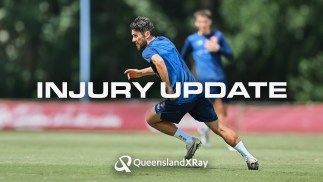The Hyundai A-League’s improving attendances can be traced back to those community clubs created by European immigrants.
For the first time since 2008/09, the average crowd for this Hyundai A-League home-and-away season is set to top the 10,000 mark.
After week 23 the average crowd stood at 10,650, which is well above the 2010/11 home-and-away season complete average of 8,450.
Excluding finals, the highest average crowd for an Australian national league season to date was 14,600. This record was set in the 2007/08 season, and was led by Melbourne Victory who averaged more than 26,000 to their regular season home matches.
It-s fascinating to chart the progress of football in Australia in terms of average crowds at the top level of domestic football over the years – and to see which clubs were most popular over time in terms of these crowds.
Back in pre-national league days, the state leagues of New South Wales and Victoria led the way in terms of quality and standard of domestic football in Australia.
The earliest record I have found for an average crowd over a domestic league season was the 1953 NSW state league season, which averaged 1000 per game. By the end of the 1950s, the average crowd got up to around 1500 per game.
Unfortunately no extensive record of crowds appears to exist for other states from the early days, although indications are that crowds in other states followed the trend in NSW, even if their crowds generally weren-t as large as NSW state league crowds.
A surge in interest at the turn of the 1960s, led by waves of football-loving immigrants from southern and eastern Europe, saw average crowds in the NSW state league rise to almost 3000 per game by 1961, reaching a peak of 3450 per game in 1963.
These were glory days of pre-national league football in Australia. In the 1963 season, Apia Leichhardt (average crowd 7500), Pan Hellenic (7300), Prague (4800), Yugal (4000) and Budapest (3800) were the biggest crowd pullers in the Sydney/Wollongong-based NSW state league.
Recently-arrived immigrants from Italy (Apia), Greece (Pan Hellenic), Czechoslovakia (Prague), pro-government Yugoslavia (Yugal) and Hungary (Budapest) formed the core support of these great clubs.
The big teams from other states included Melbourne teams Polonia (supported predominately by Polish immigrants), George Cross (Maltese) and Croatia, Juventus (Italian) from Adelaide, Hellenic (Greek) in Brisbane and Perth side Windmills (Dutch).
Not only did these clubs, through the support of these recently-arrived migrants, boost the standard and professionalism of football in Australia in the 1960s; their legacy lives on today with many supporters of these clubs the parents and grandparents of Australian football-s biggest names today.
And many of these – and other – great clubs from the time still power on today in the country-s various state leagues, their current existence after all these years a credit to their supporters- continued support over this time.
While average crowds in the NSW state league remained at impressive numbers through most of the 1960s, a demise commenced from late in the decade. From 1968 to 1976, the season average crowd dropped from 3100 to just 1500 per game.
One factor behind the dramatic decline in crowds over this time – which was probably replicated in other states – was the downturn in migrants arriving from southern Europe.
Between 1954 and 1966, the number of Australians born in Italy, Greece and Yugoslavia combined increased by an average 26,000 per year; however between 1966 and 1976 the increase was less than 10,000 per year. In fact, the population of both Italian- and Greek-born Australians declined between 1971 and 1976.
These were the supporters of some of the biggest Australian clubs of the 1960s, and their Australian-born children just didn-t seem to support their parents- club to the same extent as their dads and mums.
Given the large drop in state league crowds throughout the early 1970s, the formation of the NSL in 1977 was a timely boost for football in Australia.
Average NSL crowds stood at around 4000 per match for the first five years, which wasn-t bad considering most NSL games were directly up against established leagues of other football codes around the country.
The promising start couldn-t be maintained though, and average NSL crowds in the early 1980s dived to worrying levels. The low point came in 1985, when the league averaged just 2200 per game over the home-and-away season.
However, led by NSL newcomers Sydney Croatia (the biggest crowd-pullers from 1986 to 1988) and then Marconi (who had the biggest average crowds in 1989 and 1989/90), the overall NSL average crowd rose – from just under 2500 in 1986 to almost 3500 per game in 1990/91. The significant increase in overall crowds over these years was undoubtedly assisted by the introduction of ‘summer soccer- in 1989/90.
For five straight seasons 1990/91 to 1994/95 South Melbourne had the biggest average crowd per home-and-away season; Sydney Olympic then led the way in 1995/96, before Perth Glory took over from 1996/97. In fact, the Glory had the NSL-s highest average club home crowd for every season they took part – from 1996/97 until 2003/04. In terms of these regular season crowds, Perth-s high point came in 1997/98 when the Glory averaged 14,700 for its home matches – the highest season average ever recorded by an NSL club.
For the NSL as a whole the average crowd generally increased throughout the 1990s, peaking at 5600 in the 1998/99 home-and-away season, before declining to around 4000 over the last couple of seasons 2002/03 and 2003/04.
Much like the formation of the NSL 28 years earlier, the Hyundai A-League again injected new life into the game in Australia in 2005 – albeit with crowds averaging around three times the size of overall NSL crowds.
And with ever-increasing player participation rates, stronger senior national teams, and the rise of the women-s game, it-s hard to argue that football in Australia is not in a better shape now than it was at any time throughout the last century – despite its many contemporary challenges.
However it-s an evolution built strongly on its history, in particular from the 1960s when top-level club football was revolutionised thanks especially to the passion, dedication and commitment of the waves of ‘new Australians- of the time, predominately from throughout Europe.
Enhanced in the meantime not only by their siblings, but by a large, wide and diverse community of other football lovers, the world game has certainly made giant strides in Australia over the past fifty years.
But there-s plenty of scope for this game to get much bigger in the next fifty. Together we can make it happen.
Follow Andrew Howe-s Aussie football stats updates on Twitter @AndyHowe_statto



